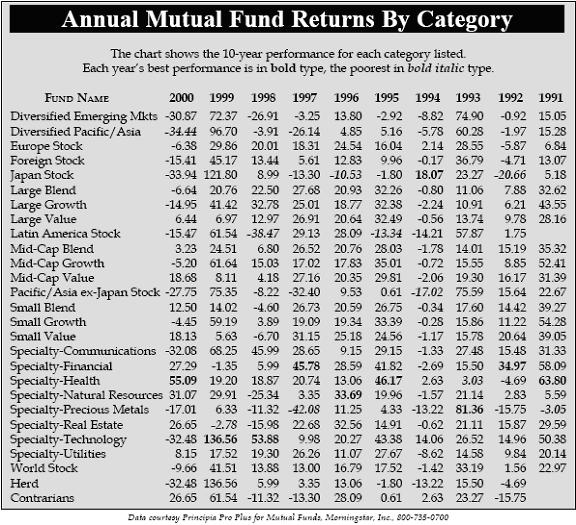I’ll have a “Bloomin’ Onion,” the 12-ounce “Outback Special” — medium rare — with the loaded baked potato and, for dessert, a slice of the Australian economy.
Australia, the world’s largest island and smallest continent, is an excellent investment opportunity. Over the past few decades, Australia’s economy has benefited greatly from its strong ties to the rapidly developing Pacific region. The country is rich with natural resources and is well positioned to act as a primary supplier to Asia and other developing regions. Such factors clearly create a favorable investment profile, yet Australia is often overshadowed by other emerging economies in the region.
Investment in the Pacific region has increased dramatically over the past decade. Lipper Inc., a global leader in mutual fund research, tracked 25 mutual funds in the Pacific ex-Japan category 10 years ago. Today, that has more than doubled to 52 funds. This category excludes funds investing exclusively in China, which Lipper tracks separately. Ten years ago, Lipper tracked 22 of those funds; today it tracks 79. Together, the Pacific ex-Japan and China categories have almost tripled, from 47 funds to 131 funds.
Looking at a better measurement of growth — assets under management — Lipper’s Pacific ex-Japan and China categories increased from $3.4 billion and $0.6 billion to $36.3 billion and $25.1 billion, respectively, from 2000 to 2010. Altogether, that’s an increase of 1,435 percent, from $4 billion to $61.4 billion. These data only include funds tracked by Lipper, not other forms of investment, such as private equity and hedge funds. Asian-focused hedge funds alone account for another $83.4 billion, according to Hedge Fund Research Inc.
The Pacific’s emerging markets received the majority of this increased investment, most notably China and India. Japan once dominated the Pacific investment universe, but after decades of a stagnant economy, the country is no longer the region’s growth engine. While China, India and other emerging markets are the new sources of growth for the region, and arguably for the global economy, investors have largely ignored Australia.
The Case For Australia
Australia’s economy has prospered in recent decades, sustained by the country’s abundant natural resources and supported by its strong trading partnerships. Australia has enjoyed 17 consecutive years of economic prosperity, with average GDP growth of 3.3 percent annually.
During the global financial crisis, Australia’s economy fared better than most. GDP growth during the worst of the financial crisis remained positive, at 2.1 percent and 1.2 percent in 2008 and 2009, respectively. In 2010, Australia’s GDP reached just over $1.2 trillion, representing a 3 percent year-over-year growth rate.
Australia avoided the worst of the financial crisis mainly because its banking system is well regulated and has limited exposure to toxic assets. Australia’s banks maintained strong lending practices, which helped save the country’s real estate market from collapse. But, more important, Australia continues to benefit from its growing trade relationship with Asia. Australia’s top four export markets are, in order, China, Japan, Korea and India — the United States is fifth.
Australia is well positioned to be a primary supplier of growth to Asia. According to Morningstar analyst Patricia Oey, “an investment in [Australia] is sometimes viewed as an indirect play on economic growth in China and the Asia region, given [Australia’s] 30 percent weighting in export-focused materials and energy companies.” Resulting in part from China’s rapidly growing need for products such as coal and iron ore, mineral exports have grown from 20 percent of Australia’s exports to more than 40 percent in the past 10 years.
Australia is more than just an export economy. The Pacific region’s growing middle class, especially in China, will provide new consumers and tourists that Australia is ready to serve. According to a research report from Matthews Asia, a leading Asian-focused mutual fund company, economic ties between Australia and Asia are broadening from the resources sectors to the consumer and financial services sectors. Australian financial companies are forming joint ventures and subsidiaries in emerging Asia, including small and medium-sized businesses looking to expand in the region.
Moreover, Australia is home to some of the world’s biggest and best-known companies. Both BHP Billiton and Rio Tinto, two giant natural resources firms, have headquarters in Australia. Foster’s, a beverage maker that produces more than 40 varieties of beer and wine, and National Australia Bank, one of Asia’s leading financial services firms, are based in Australia. News Corp., one of the world’s largest media conglomerates, was founded in Australia before moving its headquarters to the United States in 2004.
Australia’s strong economy is supported by its stable government. Reflecting both British and North American models, Australia’s government is founded on liberal democratic traditions based on the values of religious tolerance, freedom of speech, capitalism and the rule of law. Australia’s legal system, similar to that of the United States, is based on common law principles, which facilitate a stable business environment by protecting property rights and contracts.
Led by Prime Minister Julia Gillard, Australia’s centrist government has kept the country’s fiscal policies in check. After years of strong economic growth, Australia eliminated all government debt in 2005-06. Even after the spread of massive government fiscal stimulus worldwide in the wake of the financial crisis, Australia’s balance sheet remains strong. Data from the Economist Intelligence Unit estimate Australia’s public debt-to-GDP ratio will be 22 percent in 2011 — low compared with the U.S.’s 64 percent and Japan’s 198 percent. And according to projections from the International Monetary Fund, if the recovery in Australia proceeds as expected, its budget will be back in surplus by 2012-13.
The monetary position in Australia is also encouraging. The Reserve Bank of Australia (RBA), like the Federal Reserve in the United States, manages the country’s money supply by setting interest rates. With the downturn in Australia’s economy milder than expected and growth rebounding, the RBA has scaled down its stimulus policies and has started to raise interest rates. This is in contrast to the United States, which continues to push for new stimulus programs and maintains record low interest rates. Australia’s target rate is currently 4.75 percent, and inflation is expected to remain within the RBA’s desired range of 2 to 3 percent.
Australia has a strong labor market as well. At only 5 percent, Australia’s unemployment rate is one of the lowest among developed nations, and is well below its historical average. Australia’s unemployment rate has averaged around 7 percent since 1978, reaching a high of almost 11 percent in December 1992 and a record low of 4 percent in February 2008.
Despite Australia’s favorable economic position, investors and institutional money managers largely neglect it. Very few mutual funds or exchange-traded funds invest exclusively in Australia. Many of the diversified funds that focus on the broad Pacific region have little or no exposure to the country.
This neglect is not the result of a poor economic environment. Rather, analysts and fund managers typically focus on the region’s higher-growth economies, such as China and India, which tend to dominate the financial press and investor interest. Most funds that invest in the Pacific region have growth-style investment mandates, which again lead to large allocations to the fastest-growing emerging economies. Although part of the Pacific region, Australia is not an emerging economy and is therefore largely ignored.
Australia should not replace an investor’s allocation to China, India or the rest of the Pacific region; rather, it should be included as a complement. Good investing is about optimizing a portfolio’s long-term return while minimizing its overall volatility, or risk. To this end, Australia offers diversification benefits. Australia’s exposure to commodities and its lower correlation to the U.S. market relative to the widely held MSCI EAFE Index make it a good diversification tool. Commodities tend to correlate less with traditional asset classes and therefore provide diversification. Commodities also hedge against inflation, which will help protect a portfolio against rising prices. This is a major concern in the current economic environment.
Investors should evaluate their asset allocations and make room for Australia. Although few investment options exist, the iShares MSCI Australia Index Fund (ticker symbol: EWA) is a good way to gain broad exposure to Australia’s economy.
Over the coming decades, Australia will surely play a major role in the rise of the Pacific region, and thus warrants inclusion in any long-term, diversified portfolio. Don’t let your only exposure to Australia be a Saturday night dinner at Outback Steakhouse.








